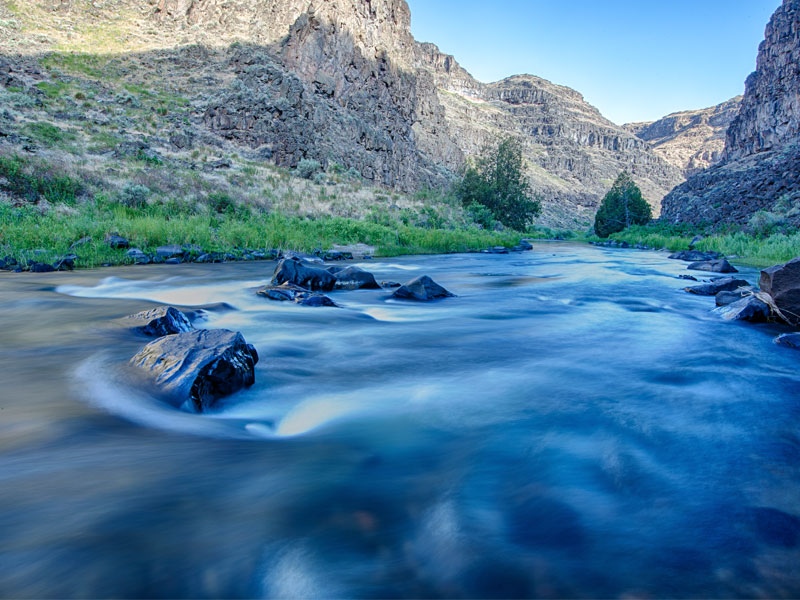Victory for Owyhee Wildernesses in Idaho!
 Wilderness Watch, joined by Western Watersheds Project, won a significant victory in 2016 for the six Wildernesses in the Owyhee region in Idaho. The victory came in our settlement of an appeal of the Bureau of Land Management’s (BLM’s) Owyhee Canyonlands Wilderness and Wild and Scenic Rivers Management Plan. Our appeal challenged decisions approving commercial trapping, unattended hunting blinds, and virtually unlimited motor vehicle use by ranchers.
Wilderness Watch, joined by Western Watersheds Project, won a significant victory in 2016 for the six Wildernesses in the Owyhee region in Idaho. The victory came in our settlement of an appeal of the Bureau of Land Management’s (BLM’s) Owyhee Canyonlands Wilderness and Wild and Scenic Rivers Management Plan. Our appeal challenged decisions approving commercial trapping, unattended hunting blinds, and virtually unlimited motor vehicle use by ranchers.
Protected in 2009 as Wilderness, the Owyhee Canyonlands complex is one of the largest intact desert ecosystems in the lower 48 states. The Canyonlands provide a spectacular maze of rugged plateaus, water-filled canyons, and a sense of remoteness rivaled by few landscapes. The six separate Wildernesses are the Owyhee River Wilderness, North Fork Owyhee Wilderness, Pole Creek Wilderness, Big Jacks Creek Wilderness, Little Jacks Creek Wilderness, and the Bruneau-Jarbidge Rivers Wilderness. Congress designated these six Wildernesses in 2009 as part of the Omnibus Public Lands Management Act. Altogether they total over 516,000 acres of Wilderness. BLM manages all six areas together under a new wilderness management plan.
But several aspects of the wilderness management plan violated the 1964 Wilderness Act and the National Environmental Policy Act. We challenged these violations with the Interior Board of Land Appeals (IBLA), and BLM decided to reach a settlement with us.
The settlement, approved by IBLA, contains the following victories for these Wildernesses:
1. Commercial Trapping Banned. BLM wanted to allow commercial trapping in these Wildernesses. Nearly all trapping is commercial, of course, and commercial activities like these are prohibited under the Wilderness Act. In the draft wilderness management plan, BLM had it right, and the draft plan prohibited commercial trapping. But the Idaho Department of Fish and Game (IDFG) pressured the BLM to reverse this position in the final plan.
2. Motor Vehicles for Ranchers Curtailed. BLM had attempted to use an unprecedented and unlawfully loose approval process in the wilderness management plan to allow ranchers to use ATVs and other motor vehicles for routine ranching activities, like herding or rounding up cows in the Wildernesses. This motor vehicle use violated the prohibitions in the Wilderness Act. Here again, the draft wilderness management plan had this provision right and prohibited motor vehicles for these activities, but the BLM caved in to pressure and changed it in the final plan.
3. Hunting Blinds Outlawed. BLM wanted to allow unattended hunting blinds in the Wildernesses, which would violate the Wilderness Act’s prohibitions on structures and installations. In addition, the purpose of unattended blinds would have been to acclimate wildlife to the presence of these structures over time so that hunters could more easily shoot them. As with both provisions above, the BLM caved in to political pressure and changed the provisions from the draft to the final wilderness plan with no explanation or analysis.
The Wilderness Act prohibits all of these activities and uses because they degrade wilderness character, and the BLM's prior drafts of the Management Plan prohibited them accordingly. The agency's about-face in the final Management Plan represented a sharp departure from its own management guidance and the mandates of the Wilderness Act.
Thanks to this victory, these six Owyhee Canyonlands Wildernesses and their wild critters will be better protected for current and future generations.
Photo: Bruneau-Jarbidge Rivers Wilderness by Bob Wick
Contact Us
Wilderness Watch
P.O. Box 9175
Missoula, MT 59807
P: 406-542-2048
E: wild@wildernesswatch.org
Minneapolis, MN Office
2833 43rd Avenue South
Minneapolis, MN 55406
P: 612-201-9266
Moscow, ID Office
P.O. Box 9765
Moscow, ID 83843
